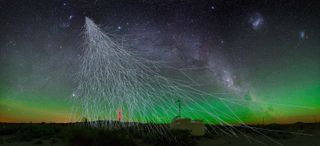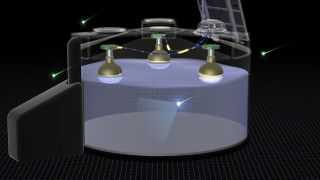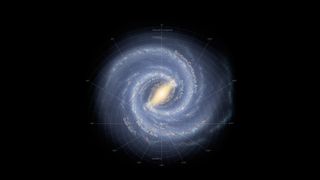Most Powerful Cosmic Rays Come from Galaxies Far, Far Away
The highest-energy cosmic rays to bombard Earth apparently come from galaxies far, far away, a new study finds.
Cosmic rays are made of atomic nuclei of elements ranging from hydrogen to iron, and zip through outer space at speeds approaching that of light. Analyzing them gives scientists a way to examine matter from outside the solar system, and potentially outside the galaxy.
The sun emits relatively low-energy cosmic rays. However, for more than 50 years, scientists have also detected ultra-high-energy cosmic rays, ones far beyond the capability of any particle accelerator on Earth to generate. [100-Year Cosmic Ray Mystery Solved with Supernovas (Photos)]

"Earth sees a constant rain of these particles, but we had no idea where they come from," study co-author Karl-Heinz Kampert, a particle astrophysicist at the University of Wuppertal in Germany and spokesman for the Pierre Auger Collaboration, told Space.com.
"The particles we detect are so energetic they have to come from astrophysical phenomena that are extremely violent," study co-author Gregory Snow at the University of Nebraska-Lincoln, who serves as the education and outreach coordinator for the Pierre Auger Observatory project, said in a statement. "Some galaxies have an explosive, massive black hole in their centers and there are theories that these very violent centers accelerate particles of very high energy that eventually reach Earth."
"By understanding the origins of these particles, we hope to understand more about the origin of the universe, the Big Bang, how galaxies and black holes formed and things like that," Snow said in the statement. "These are some of the most important questions in astrophysics."

One way to discover the origins of ultra-high-energy cosmic rays is to study their directions of travel. However, ultra-high-energy cosmic rays only rarely strike Earth's atmosphere, with one hitting any given area about the size of a soccer field about once per century, the researchers said.
Get the Space.com Newsletter
Breaking space news, the latest updates on rocket launches, skywatching events and more!
In order to detect ultra-high-energy cosmic rays, scientists look for the spray of electrons, photons and other particles that result when ultra-high-energy cosmic rays hit the top of Earth's atmosphere. Each of these showers contains more than 10 billion particles, which fly downward in a disk shaped like a giant plate miles wide, according to the statement.
Scientists examined the sprays from ultra-high-energy cosmic rays using the largest cosmic-ray observatory yet: the Pierre Auger Observatory built in the western plains of Argentina in 2001. It consists of an array of 1,600 particle detectors deployed in a hexagonal grid over 1,160 square miles (3,000 square kilometers), an area comparable in size to Rhode Island. A connected set of telescopes is also used to see the dim fluorescent light the particles in the sprays emit at night.
The researchers analyzed data collected between 2004 and 2016. During these 12 years, the scientists detected more than 30,000 ultra-high-energy cosmic rays.

If ultra-high-energy cosmic rays came from the Milky Way, one might perhaps expect them to come from all across the sky, or perhaps mostly from the direction of the supermassive black hole at the galaxy's center. However, the researchers saw that ultra-high-energy cosmic rays mostly came from a broad area of sky about 90 degrees away from the direction of the Milky Way's core.
"This is the first clear observation that ultra-high-energy cosmic rays come from outside our galaxy," Kampert said.
This direction where most of the ultra-high-energy cosmic rays came from is a place "with an increased density of nearby galaxies," Kampert added. "These galaxies, or some subset of these galaxies, contain the sources of these cosmic rays."
Future research to pinpoint the exact sources of these cosmic rays will focus on the ones with the very highest energy. These are the most likely to have gotten deflected the least by intervening magnetic fields, and so their arrival directions should point closer to their birthplaces, Kampert said.
The scientists detailed their findings in the Sept. 22 issue of the journal Science.
Follow Charles Q. Choi on Twitter @cqchoi. Follow us @Spacedotcom, Facebook and Google+. Original article on Space.com.
Join our Space Forums to keep talking space on the latest missions, night sky and more! And if you have a news tip, correction or comment, let us know at: community@space.com.

Charles Q. Choi is a contributing writer for Space.com and Live Science. He covers all things human origins and astronomy as well as physics, animals and general science topics. Charles has a Master of Arts degree from the University of Missouri-Columbia, School of Journalism and a Bachelor of Arts degree from the University of South Florida. Charles has visited every continent on Earth, drinking rancid yak butter tea in Lhasa, snorkeling with sea lions in the Galapagos and even climbing an iceberg in Antarctica. Visit him at http://www.sciwriter.us
Most Popular


